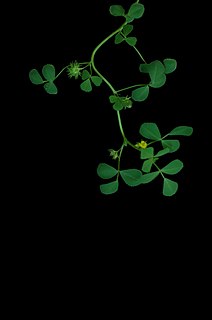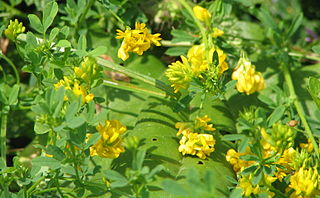
Medicago is a genus of flowering plants, commonly known as medick or burclover, in the legume family (Fabaceae). It contains at least 87 species and is distributed mainly around the Mediterranean basin. The best-known member of the genus is alfalfa, an important forage crop, and the genus name is based on the Latin name for that plant, medica, from Greek: μηδική (πόα) Median (grass). Most members of the genus are low, creeping herbs, resembling clover, but with burs. However, alfalfa grows to a height of 1 meter, and tree medick is a shrub. Members of the genus are known to produce bioactive compounds such as medicarpin and medicagenic acid. Chromosome numbers in Medicago range from 2n = 14 to 48.

Forage is a plant material eaten by grazing livestock. Historically, the term forage has meant only plants eaten by the animals directly as pasture, crop residue, or immature cereal crops, but it is also used more loosely to include similar plants cut for fodder and carried to the animals, especially as hay or silage. The term forage fish refers to small schooling fish that are preyed on by larger aquatic animals.

Medicago truncatula, the barrelclover, strong-spined medick, barrel medic, or barrel medick, is a small annual legume native to the Mediterranean region that is used in genomic research. It is a low-growing, clover-like plant 10–60 centimetres (3.9–23.6 in) tall with trifoliate leaves. Each leaflet is rounded, 1–2 centimetres (0.39–0.79 in) long, often with a dark spot in the center. The flowers are yellow, produced singly or in a small inflorescence of two to five together; the fruit is a small, spiny pod.

Root nodules are found on the roots of plants, primarily legumes, that form a symbiosis with nitrogen-fixing bacteria. Under nitrogen-limiting conditions, capable plants form a symbiotic relationship with a host-specific strain of bacteria known as rhizobia. This process has evolved multiple times within the legumes, as well as in other species found within the Rosid clade. Legume crops include beans, peas, and soybeans.
NVC community CG7 is one of the calcicolous grassland communities in the British National Vegetation Classification system. It is one of three short-sward communities associated with heavy grazing, within the lowland calcicolous grassland group, and is regarded as the eastern counterpart of "typical" chalk grassland.

Colias croceus, clouded yellow, is a small butterfly of the family Pieridae, that is, the yellows and whites.
Medic is role or occupation in medicine.

Nicotiana benthamiana is a close relative of tobacco and species of Nicotiana indigenous to Australia.

Medicago lupulina, commonly known as black medick, nonesuch, or hop clover, is a plant of dry grassland belonging to the legume or clover family. Plants of the genus Medicago, or bur clovers, are closely related to the true clovers (Trifolium) and sweet clover (Melilotus). Like the true clovers, black medick has three leaflets and a small, yellow flower closely resembling those of lesser trefoil. Black medick belongs to the same genus as alfalfa.
Uromyces striatus is a plant pathogen causing rust in Medicago. Alfalfa rust caused by Uromyces striatus is an important disease in many areas and is damaging to alfalfa grown for seed.

Medicago polymorpha is a plant species of the genus Medicago. It is native to the Mediterranean basin but is found throughout the world. It forms a symbiotic relationship with the bacterium Sinorhizobium medicae, which is capable of nitrogen fixation. Common names include California burclover, toothed bur clover, toothed medick and burr medic.

Medicago arborea is a flowering plant species in the pea and bean family Fabaceae. Common names include moon trefoil, shrub medick, alfalfa arborea, and tree medick. It is found throughout Europe and especially in the Mediterranean basin, primarily on rocky shores among shrubby vegetation. It forms a symbiotic relationship with the bacterium Sinorhizobium meliloti, which is capable of nitrogen fixation. It is the only member of the genus Medicago which is used as an ornamental. M. arborea is sometimes misidentified as Cytisus, which it resembles.
Medicago constricta is an annual, non-climbing species of the genus Medicago. It is found in the Mediterranean basin from Greece to Israel. M. constricta is found primarily in sandy clay or dry soils. It forms a symbiotic relationship with the bacterium Sinorhizobium meliloti, which is capable of nitrogen fixation.

Medicago falcata is a plant species of the genus Medicago. It is native to the Mediterranean basin, but is found throughout the world. It forms a symbiotic relationship with the bacterium Sinorhizobium meliloti, which is capable of nitrogen fixation. Its common names include yellow lucerne, sickle alfalfa, yellow-flowered alfalfa, yellow alfalfa, sickle medick and yellow medick.
Phyllonorycter medicaginella is a moth of the family Gracillariidae. It is found from Denmark and Poland to Belgium, the Alps, Bulgaria and Ukraine.

Medicarpin is a pterocarpan, a derivative of isoflavonoids.
Alfalfa is a perennial flowering plant and flower cultivated as a forage crop, foodstuff, and field nitrogen fixer in crop rotation.

4',7-Dihydroxyflavone is a flavone. It is found in Medicago truncatula in relation with the root nodulation symbiont Sinorhizobium meliloti or in seeds of Sophora viciifolia.
Polyommatus damon meinsii, the meinsii, is a butterfly subspecies of Polyommatus damon in the family Lycaenidae. It was discovered in 1971 by the German engineer Horst Meins Rugenstein and Dr. Miguel R. Gomez-Bustillo, who published it in Mariposas de la Peninsula Ibérica, Ropaloceros (II) in 1974.

Medicago Inc. is a Canadian biotechnology company focused on the discovery, development, and commercialization of virus-like particles using plants as "bioreactors" to produce proteins as candidate vaccines and medications. By using live plant leaves as hosts in the discovery and manufacturing process, the Medicago "Proficia" technology has the goal to create a rapid, high-yield system for its product candidates.











